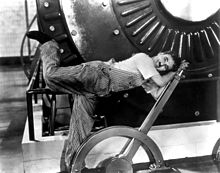Physical comedy

Physical comedy is a form of comedy focused on manipulation of the body for a humorous affect. It can include slapstick, clowning, mime, physical stunts, or making funny faces.[1]
Physical comedy originated as part of the Commedia dell'arte.[2] It is now sometimes incorporated into sitcoms; for example, in the sitcom Three's Company, actor John Ritter frequently performed pratfalls (landing on the buttocks). Cartoons also commonly depict physical comedy, such as in Tom and Jerry and Wile E. Coyote and The Road Runner[3]
Slapstick elements include the trip, the slip, the double take, the collide, the fall (or faint) and the roar.[clarification needed]
Examples
Charlie Chaplin started his film career as a physical comedian; although he developed additional means of comic expression, Chaplin's mature works continued to contain elements of slapstick.
Other comedians to employ physical comedy as a medium for their characters include Buster Keaton, The Three Stooges, Laurel and Hardy, Benny Hill, Lucille Ball, Martin Short, Chevy Chase, Don Knotts, Jerry Lewis, Johnny Lever, Dick van Dyke's character Rob Petrie on The Dick Van Dyke Show, Larry Hagman's character Major Anthony Nelson on I Dream of Jeannie, John Ritter's character Jack Tripper on Three's Company, Michael Richards's character Cosmo Kramer on Seinfeld, Neil Morrissey's character Tony in Men Behaving Badly, Rowan Atkinson's character Mr. Bean, and Jaleel White's character Steve Urkel on Family Matters.
See also
References
- ^ "Get Funny! Tips on Directing Physical Comedy". Videomaker.com. Retrieved 2015-11-29.
- ^ "History of Physical Comedy - Roundabout Theatre Company Official Blog". blog.roundabouttheatre.org. Retrieved 2015-11-29.
- ^ "What is Physical Comedy? (with pictures)". wiseGEEK. Retrieved 2015-11-29.
